I would need a Wayback to verify, but I believe Compounded was the first modern era board game to enter my collection. Before Ticket to Ride: Europe or New York 1901—even before Catan (obviously I’m a supremely late bloomer). Certainly before Everdell carried me through the tabletop floodgates, there was this little chemistry engine that could.
My wife is a biochemist and we’ve always sought out games with a scientific setting, but I would hardly label this little box a gateway game. I specifically remember wondering what I had gotten us into as I stickered the wooden discs and punched the tiny little diamond-shaped chits. After laboring through that first play, the game sat on our shelf for quite some time while we tried to develop a mental category for what we had experienced.
Compounded is a game, however, that keeps finding its way back to our table. We weren’t ready for its even moderate complexity the first time. After playing some more suitable welcoming games and familiarizing ourselves with modern mechanics, everything started to make sense, but I’m still not sure I’d say we enjoyed the next few attempts. Having now played hundreds more titles and grasped a bit more of gaming and ourselves as gamers, we’ve found the comfort zone and I’ve grown to really appreciate the pseudo-relaxation of the lab.
Designed by Darrell Louder and originally released in 2013 by Dice Hate Me Games, Compounded has modestly withstood the test of time. In 2022 Greater Than Games (Spirit Island, Sentinels of the Multiverse) successfully Kickstarted the Compounded: Peer-Reviewed Edition with a facelift and a companion roll-and-write titled Lab Notes to keep the chemically-minded discovering and researching for the foreseeable future.
For now, I’m taking a look at the past and the mid-size box that has held a unique place in our home and on our shelf.
Amalgamation
The action in Compounded is evenly divided between each player’s Lab Bench board and the central Research Field which is composed of a grid of cards depicting chemical compounds. The Lab Bench shows four test tubes, each representing a phase of the game and the player’s capacity within that phase.
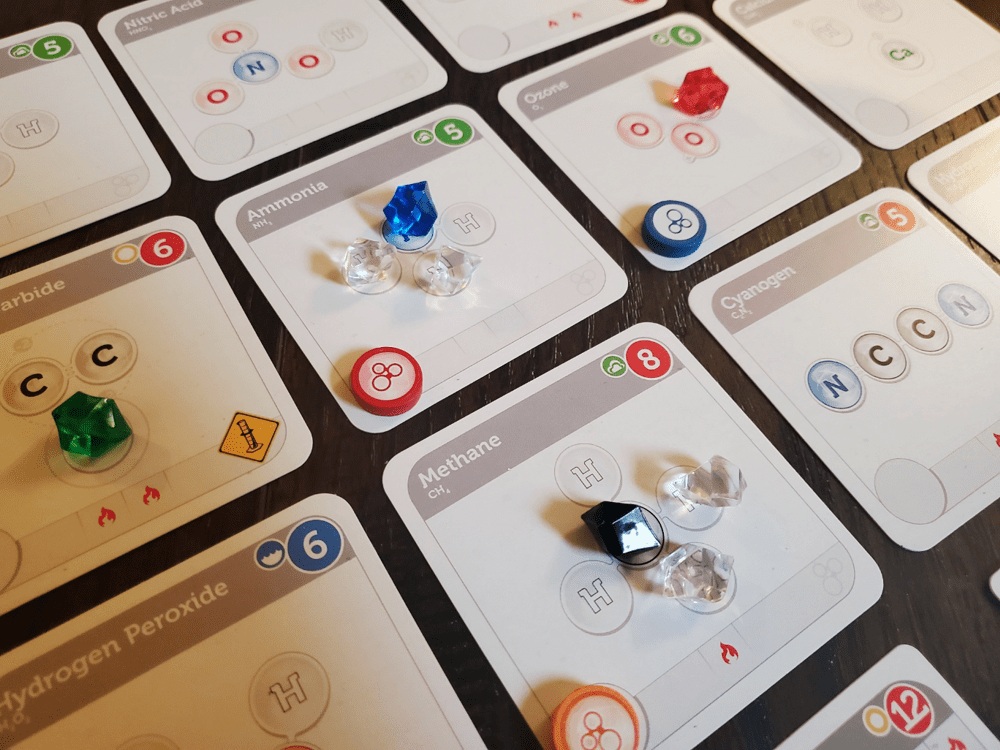
During the Discovery phase, players pass around the bag of elements (crystals) and draw their allotted number. The base game utilizes Hydrogen, Carbon, Nitrogen, Oxygen, Calcium, and Sulfur. This phase also allows for open trading of almost any component in the game, including elements, Lab Tools, Fire Extinguishers, and most intriguing, future promises. Over the course of a dozen rounds or so, trades may occur only a fraction of the time, but establishing a congenial give-and-take makes Research far more fruitful and, if I’m being honest, more fun to boot.
The Study phase then gives players the opportunity to lay claim to the various compounds in the Research Field. Players begin the game with one active Claim token and two others in their Reserve. In turn order, players employ these tokens to guarantee their stake in the benefits of the completed compound.
During Research, players assign their collected elements to various compound cards according to their capacity. There are two ways to read the rules at this point in the game. Personally, we’ve enjoyed the interpretation that players must place to their full capacity, meaning elements are often begrudgingly placed on unclaimed compounds, introducing a bit of intrigue over the Research Field. The alternative, and the design team’s suggested preference, allows for a more timid may, meaning the withholding of elements is permitted so as to avoid enticing fellow scientists to benefit from their colleagues’ abundance. I say poo poo on such stingy behaviors!
Once the elements are in play, the Lab phase brings it all home. Finished compounds are removed from the Field. Upon completion, every compound scores a number of points—marked along the Periodic Table—and grants a boon in one of the four phases: a larger draw during Discovery, another Claim token for Study, greater placement capacity in Research, or an increased capacity for elements on the Lab Bench.

In addition, many of the compounds unleash a one-time effect. These include Grants that benefit other players, Lab Fires that push volatile compounds toward combustion, and several others. Certain chemicals also bestow Lab Tools to the players such as Safety Goggles that enable an additional Discovery phase or a Bunsen Burner that pushes those volatile compounds toward combustion.
Let’s talk about combustion for a moment. In addition to the aforementioned effects, the compound deck contains a number of Lab Fire cards that also attempt to blow various chemical efforts to the heavens. Compounded LOVES its fires. When a compound is pushed beyond its limit, it is immediately removed from the game unless someone empties a Fire Extinguisher—armed by placing CO2 elements during the Research phase—on its behalf. When a card is removed, any elements currently in place scatter to adjacent cards as chosen by the compound’s owner. Just knowing there are so many ways for your work to go ka-boom keeps a certain tension in the lab and a certain importance on the Fire Extinguisher.
Once compounds are scored with their effects applied and any pesky fires attended, the round ends and play moves to another Discovery phase. The game continues in this fashion until a player either reaches 50 points or maximizes three of the four test tubes on the Lab Bench. A few extra points come from unused Fire Extinguishers, unused wild element tokens, and elements on unfinished compounds.
Augmentation
Compounded is nothing if not flexible.
The base box contains a handful of oversized compound cards that introduce a Lab Partners module to the game. With two Claim tokens necessary to finish the cards, players must either really dive all in on one of these large projects or share the work and the spoils with an opponent at the table.
For the two-player outing, the amicable Nobel joins as a third party who is always ready to trade, provided the first player decides to open that floodgate for the round. Nobel also participates in Discovery and Research, placing his elements on unclaimed compounds in the Research Field. Nobel can technically win, but with the ever-changing first player controlling most of his decisions, he becomes a pawn in the duel, swaying to the beat of two dissonant drums.
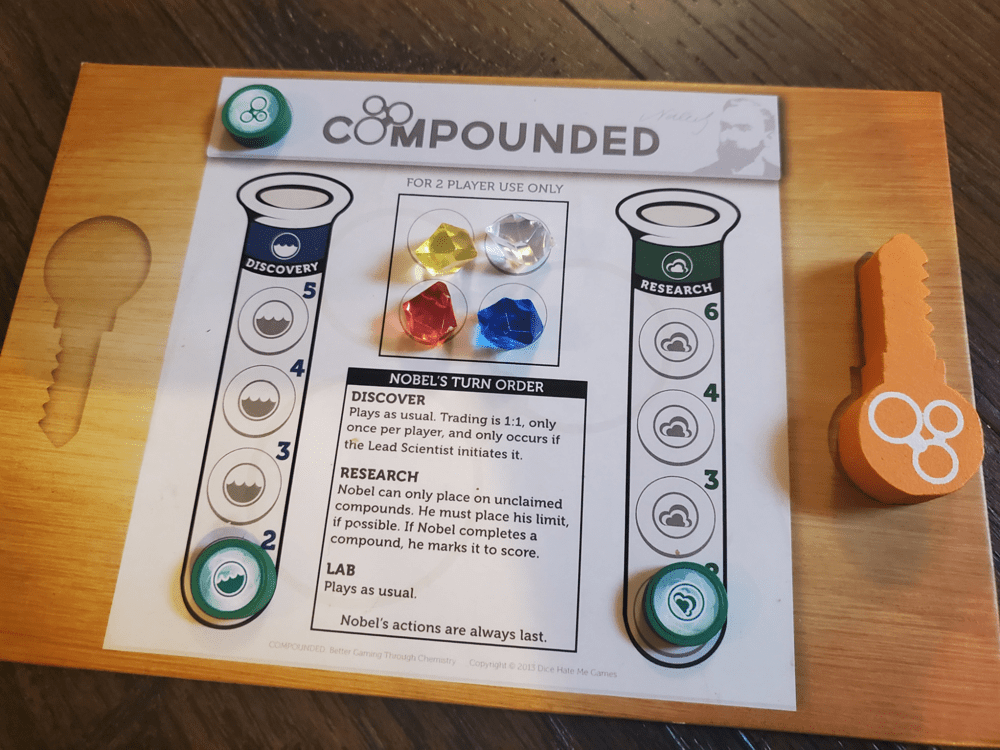
Two expansions also provide an opportunity to diversify the experience. The Chemical Chaos pack is a simple addition of 14 compound cards, each with a new and unique single-use power for the Lab Phase. Where the base game suggests nine very basic cards to populate the initial Research Field, Chemical Chaos calls for their removal in favor of a more challenging deck that pops right out of the gate. One additional Lab Fire provides the balance for the extra cards.
The Geiger Expansion is a more invasive change with new components and changes to the base game setup. Radium, Polonium, and Lead join the element stockpile, welcoming several new mechanics into the fray. Exacerbating the Lab Fire issue, Polonium triggers radiation leaks that move the Research Field toward catastrophe, but players work together to mitigate the effects by completing Cooling Compounds for mutual bonuses. Radium moves along a decay track, releasing wild Helium tokens and eventually unlocking Lead crystals for use elsewhere. New compounds introduce new and exciting tools and effects. Nobel gets his hands dirty with his own Radium decay track, and the solo mode issues salutations to a saboteur who just wants to wreck your best efforts.
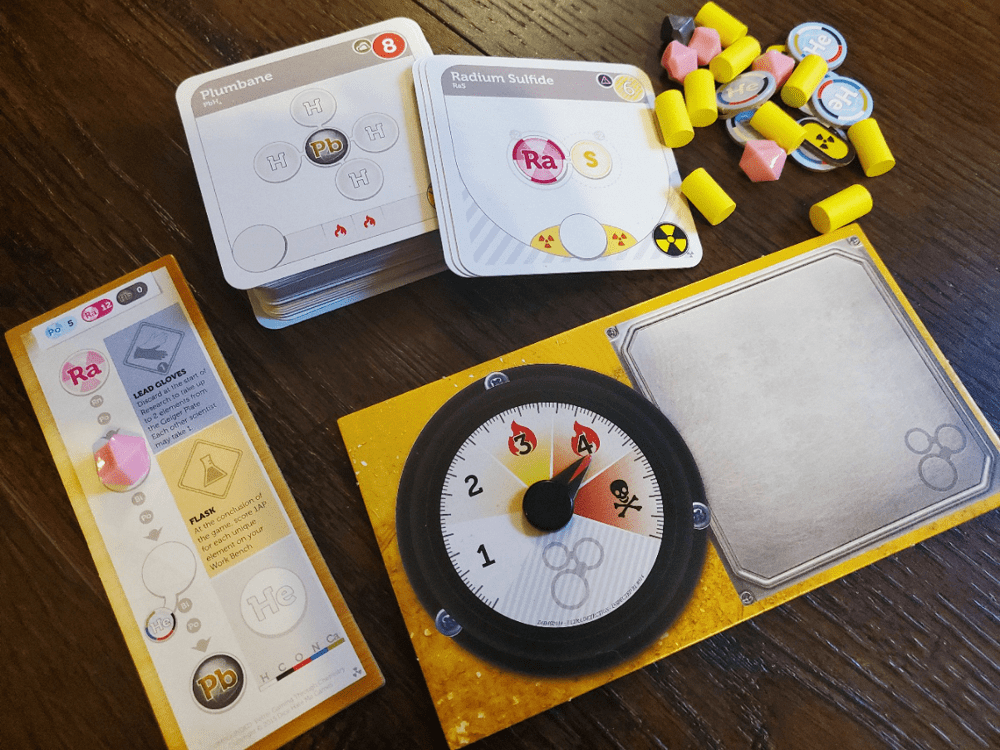
Admixture
I like Compounded.
Games that rely on trading often rely equally upon the players who sit down to the table. I can’t tell you how many games of Catan have fallen flat for me because folks weren’t willing to take a chance and just let the sheep go. So it goes with Compounded. The lifeblood of the lab is in the willingness to send out a Calcium, even a Sulfur, in exchange for a timely Oxygen. The impact is far more significant than the brief mention in the rulebook.
Similarly, games that rely on trading often rely upon the number of players who sit down to the table. Trading in any two-player outing requires a peculiar pair in my estimation, which is why games like Compounded will always work better with three, four, or more. Nobel’s presence in the two-player game is evidence for this reality. He keeps the trading gates open, but his presence can never replace the unpredictable goodness of human judgment.
When four willing participants enter the lab, Compounded is primed and ready for success. That being said, my love is only mildly conditional.
Thanks to changes in the upcoming Peer Reviewed Edition, I feel totally vindicated in our long-standing house rule that the endgame trigger belongs at 57 rather than 50. Why 57, you ask? If you recall from your high school chemistry class, the Periodic Table boasts two rows that are displayed below the table proper. The Lanthanides, which gather their name from their quality of hiding behind other elements (hence the unique placement) begin at, you guessed it, 57. When using the Table as the scoreboard, the most natural trigger is when you reach the strangeness of the Lanthanides.
I already mentioned our preferred reading of the Research rule. I believe Compounded needs a taste of the tension introduced by forced placement of the elements. This placement also forces players to attend to maintaining a balance on their Workbench. As elements are constantly flowing out in Research, Discovery must compensate. Because elements are constantly flowing out in Research, additional Study tokens take on extra value to gobble up the intrigue of primed compounds. The game’s chill atmosphere acquires just a bit of an edge with this reading. Thankfully, the syntax of our copy of the rulebook fully supports this manner of play.

Finally, Compounded was born of an era of tiny bits and stickered pieces. Golly I wish this weren’t the case. Proper setup is more cumbersome when the chits and the necessary fingers are mismatched in size. I wouldn’t change the ideas behind the components, only the components themselves. Future Bob might not worry so much about this should he acquire a copy of the upcoming release.
Those details aside, as I said, I like Compounded.
We always play with Chemical Chaos. I am happy that this little expansion allows for the removal of the starter compounds without upsetting the balance of the Lab Fires. Having slightly more challenging cards on the table from the outset makes the early game feel more important. With more than two players involved, we always use the Lab Partners module as well. Watching a pair of scientists amass the necessary elements for Nitroglycerin will light more than a hypothetical fire under the players left out of the lucrative fun. These unique and massive compounds introduce wilder swings to the scoreboard and a bit of drama to the game’s narrative arc.
We don’t play with Geiger as often, but I’ve really enjoyed our plays in the radioactive realm. There’s a bit more going on with monitoring Radium decay that extends the game in terms of time. But the decision-making surrounding the cooperative Cooling compounds is a nice interaction, and the bonus materials in the box provide a bit of livelihood to the base game: Scientist profiles granting special abilities and yet another set of unique compounds.
With the right group of four or five at the table, Compounded’s low-key tension allows for a bit of interesting interaction, while still making room for a bit of conversation. The decisions aren’t terribly challenging, but that doesn’t mean there isn’t fun in the experience. I love that I can casually set my neighbor’s Acetylene on fire without jeopardizing our friendship. I love that a Lab Fire can set half the Research Field ablaze and turn the game upside down in a matter of seconds without anyone stomping their feet or pouting. In all honesty, everyone kind of wants that to happen just to have the story to tell—provided they’ve loaded their Fire Extinguisher.
I’m not blind to the foibles of Compounded. I can see folks balking at the lack of heart-pounding thrills. I can see folks balking at the scientific theme. Oddly, I could just as easily see die-hards balking at the underutilization of the scientific theme. The Periodic Table, merely a scoreboard here, is perhaps better explored in a game like Periodic from Genius Games. Personally, I think Darrell Louder struck a lovely balance in this title that could appeal to scientific minds as well as congenial gamers without a heart for chemistry.
As it turns out, our gaming tastes have plenty of room for an hour of mostly good-natured collection and trading that so happens to use the pipet and the graduated cylinder more than on a typical Friday. I can’t complain about a game that encourages the pronunciation of Calcium Cyanamide and Peroxydisulfuric Acid while introducing a few scientific principles to marvel at this wondrous world. Nor can I complain about raising a touch of sympathy for the real-life quirks of simultaneously cooperative and competitive research or the equally mind-boggling interpersonal yet often isolating life in the laboratory. These are the latent realities that color the landscape of Compounded. If your gaming tastes fit such a mold, you might find it worthwhile to bury your hand in the element bag.
I’m more excited for the upcoming re-release than I realized. Compounded, as it turns out, has grown on us rather nicely.




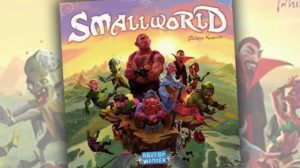
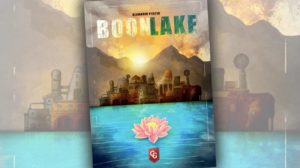





Add Comment